Manipuri Classical Dance: Graceful Tradition and Spiritual Heritage

In the northeastern state of Manipur, nestled amid verdant landscapes and rich cultural heritage, thrives an art form steeped in elegance and storytelling finesse: Manipuri classical dance. A dance form renowned for its gentle and lyrical movements, Manipuri dance is a captivating visual narrative that echoes the cultural essence of this region.
Origin and Cultural Significance
The genesis of Manipuri classical dance can be traced back to the picturesque landscapes of Manipur, a northeastern state known for its rich cultural heritage. Embedded within the traditions and folklore of this region, the dance form has evolved as an integral part of Manipuri culture, dating back centuries.
Manipur’s cultural fabric is interwoven with rituals, festivals, and storytelling traditions, where Manipuri classical dance finds its revered place. Often performed as a form of devotion, celebration, or narration, the dance plays a pivotal role in religious ceremonies, harvest festivals like Lai Haraoba, and other cultural occasions, becoming an emblem of the state’s cultural identity.
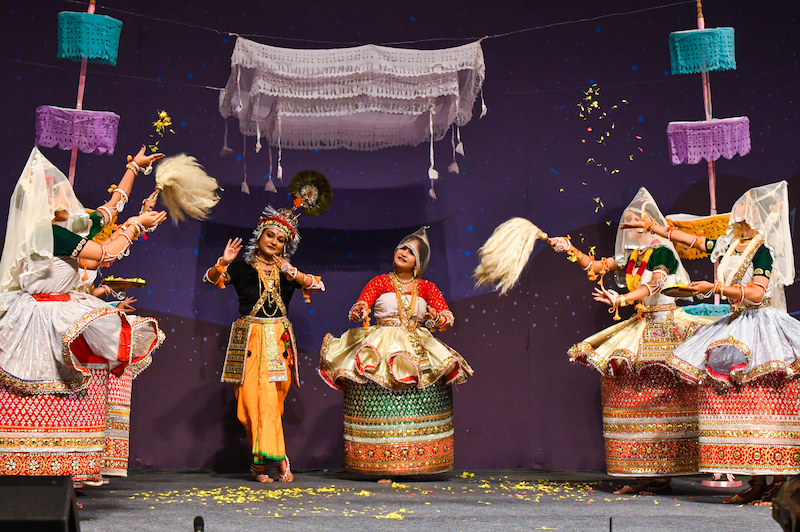
Throughout its history, Manipuri dance has undergone artistic evolution, adapting and flourishing while preserving its cultural essence. Passed down through generations, this art form has been meticulously nurtured by gurus (teachers) and disciples, ensuring the continuity of its traditions and techniques.
Beyond being a mere artistic expression, Manipuri classical dance serves as a storytelling medium, narrating tales from Hindu mythology and indigenous folklore. Each movement, each gesture, carries profound symbolism, depicting stories of love, devotion, and mythical narratives.
In the cultural ethos of Manipur, the dance holds spiritual significance, often considered a form of prayer or offering to deities. The blend of spirituality and artistry elevates the dance to a sacred realm, where movements become a means of communion with higher powers and a celebration of life’s rhythms.
Characteristics of Manipuri Dance
At the heart of Manipuri classical dance lies a distinct style characterised by its gentle, fluid, and lyrical movements. Dancers execute graceful and delicate steps, emphasising smooth transitions and expressive gestures that mirror the serene landscapes of Manipur.
Abhinaya, the expressive aspect of dance, finds exquisite expression in Manipuri dance. Dancers employ a range of facial expressions, hand gestures (mudras), and subtle body movements to convey emotions, stories, and spiritual themes with finesse and depth.
A defining feature of Manipuri dance is its emphasis on circular patterns and postures. Dancers often move in circular formations, symbolising harmony and continuity, while intricate footwork and postures enhance the visual poetry of the performance.
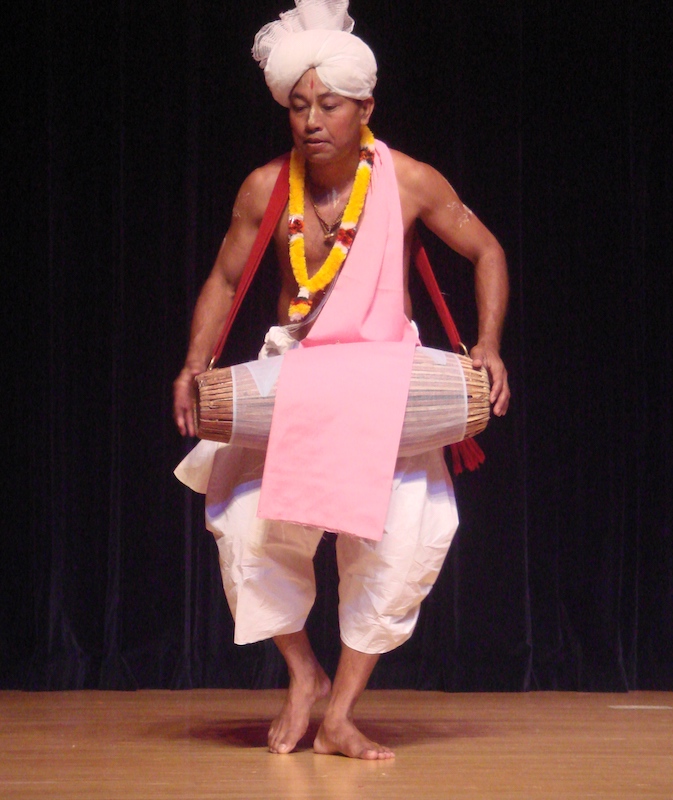
The dance form, deeply rooted in spirituality, embodies a sense of devotion and connection to divine entities. Each movement is a reverent portrayal, evoking a spiritual aura that resonates with the cultural ethos of Manipur.
Manipuri dance is adorned with vibrant, traditional costumes that add splendour to the performance. Elaborate costumes, often reflecting the cultural heritage of the region, are complemented by intricate makeup, including distinctive face painting that adds an ethereal quality to the dancers’ appearances.
The dance form seamlessly synchronises with traditional Manipuri music. Dancers move in harmony with the rhythmic beats of instruments like the Pung (drum), Kartal (cymbals), and flute, creating a mesmerising fusion of movement and melody.
Themes of love, devotion, and spirituality are central to Manipuri dance. Dancers adeptly portray tales from Hindu mythology, especially those of Radha-Krishna, through their movements, reflecting the profound emotions and narratives embedded within these stories.
Themes and Storytelling
The dance form frequently revolves around the Radha-Krishna narrative, depicting the playful interactions, yearning, and spiritual union between the divine lovers. Dancers intricately portray the emotions, joys, and challenges of their love saga, captivating audiences with the depth of their storytelling. Apart from mythological themes, Manipuri dance also draws inspiration from local folklore, showcasing stories of heroism, valour, and cultural heritage. These narratives celebrate the indigenous tales and historical legacies that have been passed down through generations in Manipur.
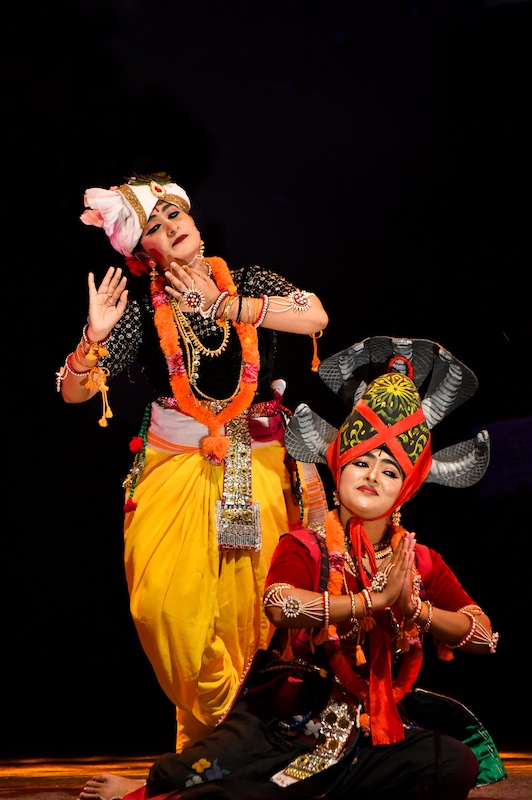
Nature’s elements often find representation in Manipuri dance, with movements mimicking the sway of trees, the flow of rivers, or the gentle rustle of leaves. Festivals and celebratory occasions are also portrayed, celebrating the cultural vibrancy of Manipur’s traditions. The dance form employs a rich array of gestures (mudras) and expressions to convey emotions. Dancers use intricate hand movements, facial expressions, and body postures to articulate a wide spectrum of feelings, adding layers of emotional depth to the performance.
Traditional Manipuri Music and Accompaniment
Manipuri classical dance is intricately entwined with traditional Manipuri music, forming a harmonious synergy between movement and melody. The Pung, a barrel-shaped drum, takes centre stage, producing rhythmic beats that set the pace for the dance. Accompanying it are the Kartal, small cymbals that add nuanced percussive elements, and the haunting tunes of the flute, which enrich the melodic tapestry.
The dance is choreographed in harmony with classical ragas and talas, contributing to the intricate patterns and rhythms that define Manipuri classical music. Ragas, the melodic structures, and talas, the rhythmic cycles, provide a framework for the dancers to synchronise their movements, creating a mesmerising fusion of music and dance.
The music accompanying Manipuri dance often comprises devotional compositions and chants, invoking spiritual fervour and setting the tone for the performance. These compositions, steeped in traditional melodies and lyrics, enhance the sacred aura of the dance, elevating it to a divine experience.
Costumes and Makeup
Manipuri classical dance is adorned with vibrant and intricately designed costumes that add splendour and elegance to the performances. The attire is characterised by its vivid colours, exquisite designs, and traditional aesthetics, reflecting the cultural heritage of Manipur. Dancers don attire such as the Kumil (skirt) for females and the dhoti-kurta or churidar for males, adorned with intricate embroidery, sequins, and traditional motifs.
The costumes are complemented by an array of traditional jewellry and accessories that accentuate the dancers’ attire. Elaborate necklaces, earrings, bangles, and anklets, often crafted from precious metals and adorned with gemstones, add a touch of opulence and grace to the overall appearance.
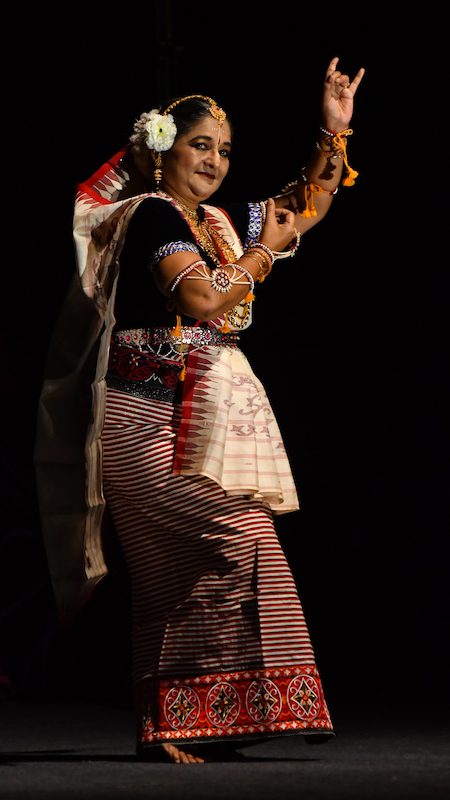
A striking feature of Manipuri classical dance is the unique makeup worn by performers. The makeup, characterised by intricate facial designs and patterns, adds an ethereal and mystical quality to the dancers’ appearances. Artists use white chalk or rice powder to create distinct patterns on the face, enhancing expressions and highlighting facial features.
The makeup worn by dancers holds symbolic significance, with each design and pattern conveying specific meanings. The patterns often represent mythical characters, celestial elements, or emotions, contributing to the visual storytelling aspect of the performance. The dancers’ hairdos also play a significant role in completing their traditional appearance. Intricately braided hairstyles adorned with flowers, ornaments, or traditional hair accessories add a regal and refined touch to the overall presentation.
Internationally Acknowledged Presence
In the context of Armenia-India relations, Manipuri classical dance received significant recognition reflected in a 2018 postage stamp issued by Armenia. This commemorative stamp portrayed the Manipuri dance form alongside Armenia’s Hov Arek, acknowledging both as representative of their respective national dances. The joint issue of postage stamps by Armenia and India highlighted the cultural significance and artistic depth of these traditional dance forms.
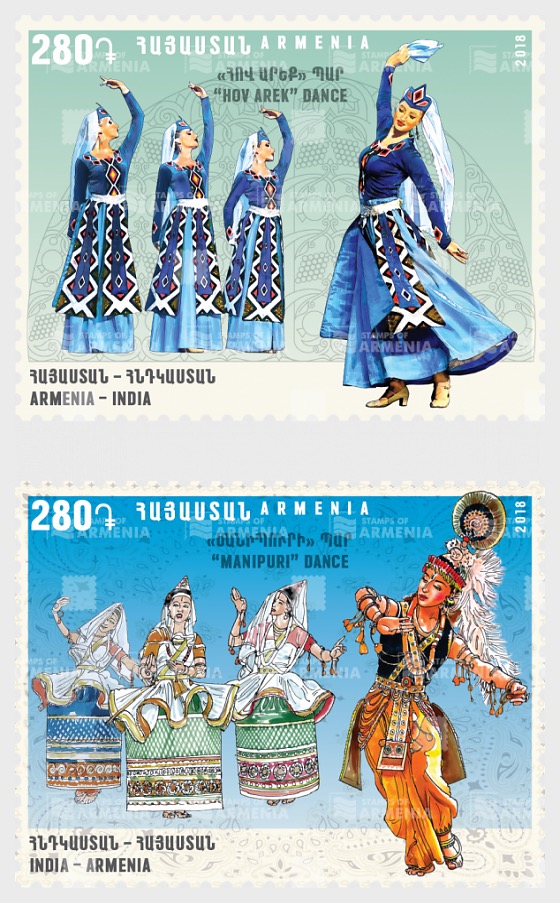
The acclaim for Manipuri classical dance extends to various global cultural events, where it has been esteemed and celebrated. This includes prominent platforms such as the International Classical Manipuri Dance Festival, International Dance Day, International Dance Festival-Silicon Valley, Samarpan (an international classical Manipuri dance festival), International Indian Classical Dance festival (INDICLAD), International Folk-Lore Festival, as well as grand events like the Opening Ceremony of Asian Games in Seoul, 1986, and the 5th International Theatre Festival in London, 1989. These international showcases have honored and showcased the richness and artistry embedded within Manipuri classical dance on a global stage.
Conclusion
The elegant art of Manipuri classical dance is a vibrant tapestry, intricately woven with grace and tradition, showcasing the rich cultural heritage of Manipur. With its gentle movements and spiritual depth, this dance form transcends performance, embodying grace, spirituality, and devotion. Adorned with vibrant costumes and intricate makeup, it preserves the region’s history and cultural identity. Cherished across generations, it celebrates Manipur’s artistic splendor, captivating audiences worldwide and leaving an indelible mark with its emotive storytelling. Ultimately, Manipuri classical dance is more than an art form; it’s a testament to Manipur’s enduring spirit, embodying grace, tradition, and cultural vibrancy.





